Insulating the basement ceiling will def make the upstairs warmer, and render the basement much colder, increase your dehumidifier needs, and otherwise make it a permanently suckier place to be (until the next owner pulls the insulation out). Versus wall insulation and voila, a huge new finished space that is actually comfortable and pleasant and boosts resale.
Basement Sprayfoam Quote
- Thread starter mass_burner
- Start date
-
Active since 1995, Hearth.com is THE place on the internet for free information and advice about wood stoves, pellet stoves and other energy saving equipment.
We strive to provide opinions, articles, discussions and history related to Hearth Products and in a more general sense, energy issues.
We promote the EFFICIENT, RESPONSIBLE, CLEAN and SAFE use of all fuels, whether renewable or fossil.
You are using an out of date browser. It may not display this or other websites correctly.
You should upgrade or use an alternative browser.
You should upgrade or use an alternative browser.
- Status
- Not open for further replies.
DickRussell
Feeling the Heat
Ditto what woodgeek just said. Heat always moves from warm toward cold. If there is heat movement, there is a temperature difference. If your basement is mid 50s and the ground outside the foundation walls is low 50s and progressively cooler up toward the sill, then it's losing heat. That heat is made up partly by any leakage from the heating system and hot water heater and partly by loss of heat from the floor above. The heat lost by the floor to the basement must be made up by heat from the air in the room above that floor surface, so it must be cooler than the room air temperature. Either insulating under that floor or making the basement warmer (by retarding the loss of heat from the basement through the walls via insulation) will bring the floor temperature closer to that of the air in the room.
Aside from saving on heating cost and improving thermal comfort, both in the basement and in the room above, another reason for insulating the walls has to do with moisture. Despite whatever "dampproofing" may have been applied to the outside of the foundation wall prior to backfilling, that concrete mass always has moisture in it, assuming that the dampproofing was not heavier actual waterproofing and that there was no capillary break placed over the footing before the walls were poured. That moisture always migrates inward to the basement air space. It evaporates quickly, helped by your dehumidification. Without that dehumidification, there could well be that mustiness common to many basements, especially in summer. If the foundation walls are close to ground temperature (you said that the basement stays mid 50s), and summertime humid air masses regularly get to dewpoints mid 60s and higher, you have the tendency of the moisture in that air to condense/be absorbed by the wall surface, fighting your active dehumidification. Insulating the walls with closed cell foam (spray or rigid board) not only warms up the surface that the air sees (thwarting condensation) but also retards migration of water vapor from the concrete into the room. This lessens the load on the dehumidifier and practically eliminates any tendency to develop musty smells, generally enhancing air quality and usefulness of the basement space.
Insulating the basement walls doesn't have to be a terribly expensive project, if you're at all handy with minimal construction projects and thus can DIY it. Done yourself, you can piecemeal it over time, using rigid foam board; I'd recommend 2" board. You will have to provide thermal protection for either type of foam, unless it's foil-faced polyiso (kept 1/2" off the floor). Studs on the flat over the foam and screwed through to the concrete provide space for wiring and shallow electrical boxes before sheetrocking, another DIY effort.
Aside from saving on heating cost and improving thermal comfort, both in the basement and in the room above, another reason for insulating the walls has to do with moisture. Despite whatever "dampproofing" may have been applied to the outside of the foundation wall prior to backfilling, that concrete mass always has moisture in it, assuming that the dampproofing was not heavier actual waterproofing and that there was no capillary break placed over the footing before the walls were poured. That moisture always migrates inward to the basement air space. It evaporates quickly, helped by your dehumidification. Without that dehumidification, there could well be that mustiness common to many basements, especially in summer. If the foundation walls are close to ground temperature (you said that the basement stays mid 50s), and summertime humid air masses regularly get to dewpoints mid 60s and higher, you have the tendency of the moisture in that air to condense/be absorbed by the wall surface, fighting your active dehumidification. Insulating the walls with closed cell foam (spray or rigid board) not only warms up the surface that the air sees (thwarting condensation) but also retards migration of water vapor from the concrete into the room. This lessens the load on the dehumidifier and practically eliminates any tendency to develop musty smells, generally enhancing air quality and usefulness of the basement space.
Insulating the basement walls doesn't have to be a terribly expensive project, if you're at all handy with minimal construction projects and thus can DIY it. Done yourself, you can piecemeal it over time, using rigid foam board; I'd recommend 2" board. You will have to provide thermal protection for either type of foam, unless it's foil-faced polyiso (kept 1/2" off the floor). Studs on the flat over the foam and screwed through to the concrete provide space for wiring and shallow electrical boxes before sheetrocking, another DIY effort.
so should a ceiling ever be spray foamed if the space under it is not living space, just a pass through area?
moey
Minister of Fire
so should a ceiling ever be spray foamed if the space under it is not living space, just a pass through area?
The only time I would spray foam a basement ceiling was if it was dirt floor or something nasty where you never go down for any reason.
velvetfoot
Minister of Fire
On a side note, would it be worth the hassle for me to remove the insulation in my basement ceiling? The basement walls have 4" of xps foam on them.
The only time I would spray foam a basement ceiling was if it was dirt floor or something nasty where you never go down for any reason.
Okay, this worries me cause the quote I got also include the area where the stairs come down to the garage from the kitchen. Quote calls for the ceiling to get completely foamed and interior walls insulated. This area is affected more by the colder garage air and outside walls where the stairs come down. This area is about 8x20. I am attaching some pic as a visual.
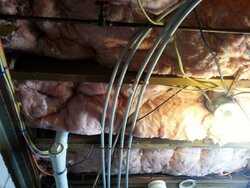
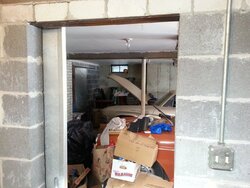
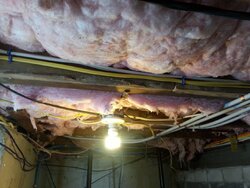
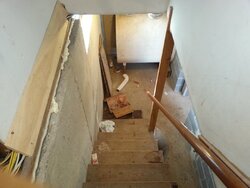
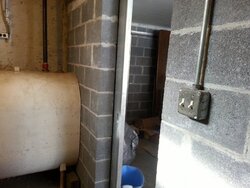
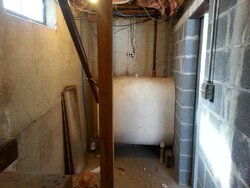
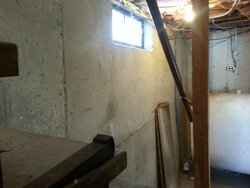
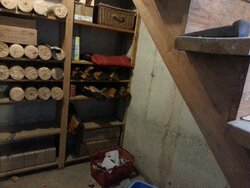
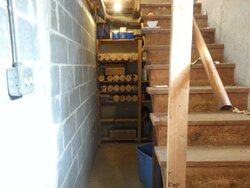
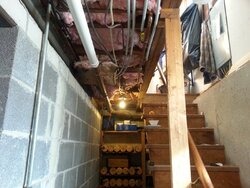
The earth is a giant heatsink. It will suck btus to get from 55 to 70 forever. Insulate the basement walls, then drywall for a smoothwall surface. Then get rid of the basement ceiling insulation if the desire is to heat from the basement.
The earth is a giant heatsink. It will suck btus to get from 55 to 70 forever. Insulate the basement walls, then drywall for a smoothwall surface. Then get rid of the basement ceiling insulation if the desire is to heat from the basement.
This area in the pics is not living space, its only a walk-through area. It will never be heated from below. Its closed off from the larger area of the basement by two 2" insulated doors. The issue is that this walk-through area is directly under the kitchen in the part of the common area furthest from the inserts. The heat eventually gets there, but as you can imagine the sink/counter/stove area is the area first used in the mornings.
moey
Minister of Fire
You may ask them the advantages of doing the ceiling if your doing the walls. The company may have simply saw you had insulation on the ceiling and gave you a quote for replacing it. You may be reading into it to much.
Your basement looks fairly deep for the coin you would spend insulating the ceiling you could do the floor and completely encapsulate the environment and never have problems with moisture low temps etc.
Your basement looks fairly deep for the coin you would spend insulating the ceiling you could do the floor and completely encapsulate the environment and never have problems with moisture low temps etc.
Circus
Feeling the Heat
Warning: Smoldering foam insulation produces highly toxic fumes, it must be sealed with something non flamable. My first cousin and her family died after a furnace blower kicked in and spread the fumes throughout the house. A cigarette started the foam insulation smoldering behind paneling of a basement wall. House was undamaged.
When I sealed my sill, I used fiberglass, drywall and caulk.
When I sealed my sill, I used fiberglass, drywall and caulk.
I read somewhere that the rule if thumb for spray foam on ceiling was if the space below it was conditioned or not. well the space below my kitchen is not and is also sealed from any space that is conditioned, as in the rest of the basement. I think spray foam is a good solution. especially since the stairs are resting hard against the wall. that would be a challenge to insulate with foam board.
AK13
Feeling the Heat
I read somewhere that the rule if thumb for spray foam on ceiling was if the space below it was conditioned or not. well the space below my kitchen is not and is also sealed from any space that is conditioned, as in the rest of the basement. I think spray foam is a good solution. especially since the stairs are resting hard against the wall. that would be a challenge to insulate with foam board.
Here is my rule of thumb for insulation. If the basement or crawlspace is completely unconditioned space then it would find to make the ceiling your insulation plane and insulate AND air seal it. But that means absolutely no heat in the basement at all. No pipes. Not heating equipment, nada. If its truly a COLD space then absolutely insulate it out of the house and you have that much less space to heat.
My friend has a ranch with a 3' tall crawlspace and poured floor. Fiberglass in the ceiling (all falling down). This might be fine except that his boiler and heating piping are down there. So that is a heated space! And where do you think the heat goes (hint: not up into the house except where the insulation is falling down). It goes out the sill and foundation walls. Since this is heated space we want to remove the insulation at the floor/ceiling and insulate the sills and the foundation walls. That is the correct way to do the job.
Retired Guy
Minister of Fire
I understand your idea to insulate the rim joist however, for those of us living in termite country the rim joist is where the critters are easiest found.
Regarding insulating the concrete walls, I remember a Materials Science Prof's little poem when we were discussing the insulating factor of stone and concrete.
"when I walked through marble halls, I froze both my ba###"
Regarding insulating the concrete walls, I remember a Materials Science Prof's little poem when we were discussing the insulating factor of stone and concrete.
"when I walked through marble halls, I froze both my ba###"
1. i always assumed the 60d was coming from the earth around the basement walls. In summer, its still 65, although the temp upstairs is 95. We don't have AC.
2. the basement. where the sill work is needed is roughly 30' x 25', maybe bigger. i'll take a measurement tonight.
inner basement area is 40 x 25, open area no inner walls, 3 outer walls. that does NOT include the garage or area at the bottom of the stairs that I want spray foamed.
I've seen stairwells to basement insulated just so the walls in the living space on the other side don't feel cold.
I've warmed up ( and helped dry ) basements here in NE in gravel just by making successful efforts at removing as much water/moisture from the soil around the basement walls. Making sure roof water drains away as far away as possible via pipes/dry wells, slope for surface water to run off .
I've warmed up ( and helped dry ) basements here in NE in gravel just by making successful efforts at removing as much water/moisture from the soil around the basement walls. Making sure roof water drains away as far away as possible via pipes/dry wells, slope for surface water to run off .
I've seen stairwells to basement insulated just so the walls in the living space on the other side don't feel cold.
I've warmed up ( and helped dry ) basements here in NE in gravel just by making successful efforts at removing as much water/moisture from the soil around the basement walls. Making sure roof water drains away as far away as possible via pipes/dry wells, slope for surface water to run off .
at present I have no water issues, but i'm working my way around the house to keep it that way.
side 1 - a slab patio with deck attached, filled remaing part with gravel, dug new 8' descending water run into yard under ground.
side 2 - garage and driveway slopes away from house, no issue.
side 3 - gutter spouts buried to 8' from foundation into yard. will be installing gravel this spring against foundation
side 4 - will be installing gravel this spring against foundation.
house is on a hill and 3 sides slope down away from house. only rear of house is level with remaining land.
Swedishchef
Minister of Fire
I sprayfoamed the my basement walls and rim joists with closed cell, R10. Then added R14 roxul. It gives me R24 and with the roxul was a bit cheaper than R20 sprayfoam.
Spray foaming the rim joists is incredible...NO cold at all coming in.
Now I have a gyprock ceiling and I didn't put insulation in. My basement is now used 50% of the time and that is where my woodstove is located.
Andrew
Spray foaming the rim joists is incredible...NO cold at all coming in.
Now I have a gyprock ceiling and I didn't put insulation in. My basement is now used 50% of the time and that is where my woodstove is located.
Andrew
I came darn close to starting a spray foam business in the summer of 2008. A minor disturbance in global financial markets ensued and the business was shelved. If given a choice between open cell and closed, go with closed cell and don't look back. It's not just a higher R value from closed cell, rather, it is impermeable by moisture. Shooting open cell on block walls is an invitation for moisture infiltration, and if you have 2x4 studs up against the cinder block and then sheetrock over it, that could be trouble. Bayseal is a good brand of closed cell and should be available for about $1.00 per board foot installed. You will need 50% less depth on a closed cell application due to its higher R value. 3 inches on a wall would be plenty.
I had the rim joists in my unfinished, unheated basement sprayed last December. I had 3" of the closed cell foam sprayed in for R20. The R value of the closed cell is slightly higher. I think I may have read something about the open cell being more moisture permeable a while ago too. You'll have to look into both types yourself to see which is best for you.
Prior to having the rim joists sprayed there were fiberglass batts (R19) on the basement ceiling that were falling down and had suffered wind damage due to unsealed rim joists. I removed most of them. The floor above, which is heated space, felt like you were walking on an ice rink on the cold and windy days. After having the rim joists sprayed it now feels slightly cool on the cold and windy days but it's a significant improvement.
My basement is also a sunken poured concrete foundation. iIconsidered having the spray foam brought down from the rim joists to the frost line on the walls but did not want to spend the extra money at the time. I paid $850 and it's a 2400 sq foot colonial, typical footprint. I may have it done at a later point in time.
I also went around and sealed up the basement sealing holes/airways with Great Stuff in Decmeber, trying to isolate the airflow to/from the living space. Now I may be experiencing an issue with draft and combustion pertaining to my pellet boiler due to sealing up the basement which is where the boiler lives. I'm in the process of experimenting with outside air at the moment. Just another possible thing to think about though.
Prior to having the rim joists sprayed there were fiberglass batts (R19) on the basement ceiling that were falling down and had suffered wind damage due to unsealed rim joists. I removed most of them. The floor above, which is heated space, felt like you were walking on an ice rink on the cold and windy days. After having the rim joists sprayed it now feels slightly cool on the cold and windy days but it's a significant improvement.
My basement is also a sunken poured concrete foundation. iIconsidered having the spray foam brought down from the rim joists to the frost line on the walls but did not want to spend the extra money at the time. I paid $850 and it's a 2400 sq foot colonial, typical footprint. I may have it done at a later point in time.
I also went around and sealed up the basement sealing holes/airways with Great Stuff in Decmeber, trying to isolate the airflow to/from the living space. Now I may be experiencing an issue with draft and combustion pertaining to my pellet boiler due to sealing up the basement which is where the boiler lives. I'm in the process of experimenting with outside air at the moment. Just another possible thing to think about though.
so should a ceiling ever be spray foamed if the space under it is not living space, just a pass through area?
This is an interesting question not only from the heating/insulation perspective but also when thinking about safety/fire hazard.
It's my understanding that the spray foam is very flammable and an the intumecscent coating must be applied to the finished product to allow a 15 minute fire barrier. I had this applied and was also told that there was something in the foam to make it inflammable. However right above the basement ceiling in most homes is the most active living space, kitchen, living room etc. etc There are also many electrical wires running along the basement ceiling in may homes. It's kind of a scary thought to think that there could possibly be a fire started on the basement ceilign which could turn into a raging inferno in a matter of moments due to highly combustible spray foam. Is my thinking wrong on this? What is eveyone else's take on it?
I don;t know which is worse, the flammability or the thick acrid black choking and gagging smoke . The smoke it makes ( with/without a flame ) is supposed to be really bad.This is an interesting question not only from the heating/insulation perspective but also when thinking about safety/fire hazard.
It's my understanding that the spray foam is very flammable and an the intumecscent coating must be applied to the finished product to allow a 15 minute fire barrier. I had this applied and was also told that there was something in the foam to make it inflammable. However right above the basement ceiling in most homes is the most active living space, kitchen, living room etc. etc There are also many electrical wires running along the basement ceiling in may homes. It's kind of a scary thought to think that there could possibly be a fire started on the basement ceilign which could turn into a raging inferno in a matter of moments due to highly combustible spray foam. Is my thinking wrong on this? What is eveyone else's take on it?
Swedishchef
Minister of Fire
When spray foam burns it gives off lots of free radicals and the black smoke will kill you in 15-30 seconds (if thick...).
Yes, it does need to be fireproofed. Normally the installer can spray a fire barrier on top. However, i was informed from my National Building Code that placing Roxul on top is perfectly acceptable.
Just remember that technically the foam boards are the same.
Andrew
Yes, it does need to be fireproofed. Normally the installer can spray a fire barrier on top. However, i was informed from my National Building Code that placing Roxul on top is perfectly acceptable.
Just remember that technically the foam boards are the same.
Andrew
okay, still pondering the open cell vs closed cell for my basement rim joists and untreated space below my kitchen (8x20 ceiling spray foam). Insulation guy thinks open cell would work and closed cell would be wasted additional cost. But I'm concerned that OC is not a vapor barrier.
I know little on the topic but closed cell is reported to be the best vapor barrier. Best to consult the experts.
http://www.icynene.com/architects/s...-open-cell-closed-cell-spray-foam-insulations
Advise seems to be to use closed cell for below grade (or rigid)
http://www.greenbuildingadvisor.com/blogs/dept/musings/how-insulate-basement-wall
Here it sounds more like they are talking about above grade walls.
http://www.greenbuildingadvisor.com...ng-blog/open-cell-foam-beats-closed-cell-foam
http://www.icynene.com/architects/s...-open-cell-closed-cell-spray-foam-insulations
Advise seems to be to use closed cell for below grade (or rigid)
http://www.greenbuildingadvisor.com/blogs/dept/musings/how-insulate-basement-wall
Here it sounds more like they are talking about above grade walls.
http://www.greenbuildingadvisor.com...ng-blog/open-cell-foam-beats-closed-cell-foam
Last edited:
- Status
- Not open for further replies.
Similar threads
- Replies
- 36
- Views
- 3K
- Replies
- 23
- Views
- 2K
- Replies
- 11
- Views
- 2K
- Replies
- 1
- Views
- 780

